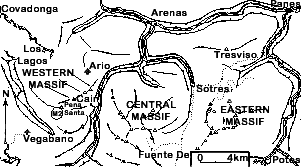|
|
|
Geology
The Picos de Europa
 The Picos de Europa massif constitutes a unit located in the most easterly
part of the Cantabrian Zone within the
The three massifs of the Picos de Europa are composed almost entirely of which were laid down during the of between 290 and 345 million years ago. In the Western Massif approximately 1200 metres of carbonates were deposited with very few impermeable horizons so that The Picos de Europa massif constitutes a unit located in the most easterly
part of the Cantabrian Zone within the
The three massifs of the Picos de Europa are composed almost entirely of which were laid down during the of between 290 and 345 million years ago. In the Western Massif approximately 1200 metres of carbonates were deposited with very few impermeable horizons so that
 most are suitable for cave development. The
geological history of the Picos de Europa since the beginning of the Carboniferous resulted in a region
with large speleological potential and the development of cave systems such as
Pozo de Cuetalbo
(M2) and Pozo del Llastrale (β3) are intimately related to the geological structure
and lithology. most are suitable for cave development. The
geological history of the Picos de Europa since the beginning of the Carboniferous resulted in a region
with large speleological potential and the development of cave systems such as
Pozo de Cuetalbo
(M2) and Pozo del Llastrale (β3) are intimately related to the geological structure
and lithology.
Bibliography
-
 Geology and speleogenesis of the M2 Cave System, Western Massif, Picos de Europa, Northern Spain, Kevin J Senior (YUCPC), Cave Science, 1987,
14, 3, 93-104, in English. PDF (5MB)
Geology and speleogenesis of the M2 Cave System, Western Massif, Picos de Europa, Northern Spain, Kevin J Senior (YUCPC), Cave Science, 1987,
14, 3, 93-104, in English. PDF (5MB)
|
|
|
|